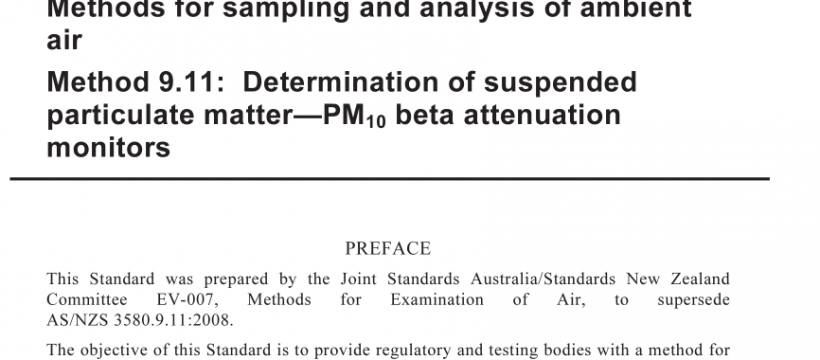AS NZS 3580.9.11:2016 pdf free download
AS NZS 3580.9.11:2016 pdf free download.Methods for sampling and analysis of ambient air
12.3 Data acquisition and transfer
The integrity of the data being recorded by the data capture system shall be checked annually. The integrity of the data transfer process, whether via manual data entry or by automated telemetry shall also be checked annually.
If an external data storage medium is used in conjunction with a BAM, e.g. an external data logger, and this involves the conversion of electrical signals, e.g. voltage to digital signals, then this shall be calibrated annually. The measurements stored on the external system shall be within ± 0.2% of the operational full scale range of the BAM.
NOTE: Some BAMs do not measure continuously and will output the results of a sample only after the sample interval has finished. Care should be taken to ensure the data logger applies an appropriate time and date stamp (or by other data handling methods) that clearly identifies when the sample was taken.
12.4 Data validation
Data collected in accordance with this Standard shall be validated prior to its use. The data validation process shall consist of a review of the data by trained personnel using data screening criteria to identify possible incorrect values (e.g. data collected during calibration or maintenance procedures mixed with sample data). This process should be conducted on a regular basis to avoid the invalidation of large quantities of data. The screening process is usually based on historical data or realistically expected values. Other values may be appropriate for a given location; therefore site-specific screening values shall then be developed. If the data does not fall within the screening criteria, the validity of the data shall be investigated. Relationships between different variables are considered when evaluating data since other parameters may either confirm or deny recorded events (e.g. wind direction changes, low visibility, etc.). The data review is an ongoing process, which shall include—
(a) review of calibration information, the recorded data, and any status flags that could affect data; and
(b) review of all calibrations, verification checks, station notes and maintenance sheets and instrument status logs.
AS NZS 3580.9.11:2016 pdf free download
